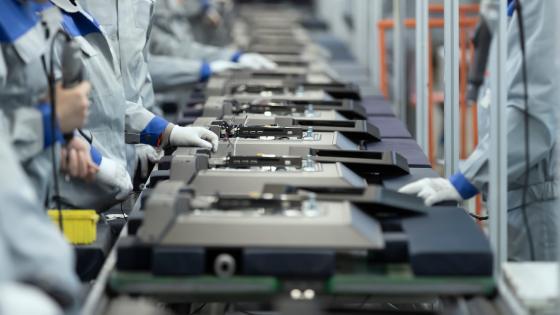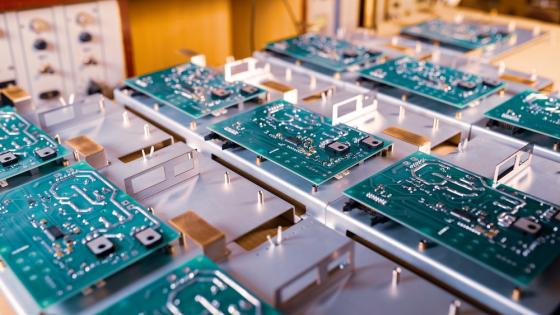The lion’s share of smartphones, computers, televisions, semiconductor devices, and other electronics goods are made in East Asia. How did Asian firms and workers acquire the know-how and skills to produce sophisticated electronic goods? Yoshitomi (2003) emphasised that initial conditions such as high saving rates, prudent fiscal policy, low inflation, and flexible labour markets facilitate capital formation. Since knowledge and technology are often imbedded in imported capital goods, favourable initial conditions that facilitate capital deepening contribute to learning.
Stages of technological progress
Initially, technologies are imported as a whole. Local firms only assemble foreign parts and components. Foreign suppliers provide technical assistance and advice because they benefit if the technology works and the goods meet high quality standards.
As domestic workers acquire production experience, they assimilate new technologies. Countries with more educated workforces are able to master new technologies more quickly. Firms also engage in research and development and reverse engineering and make limited innovations.
As firms face competition in foreign markets, their incentive to improve their technologies increases. Exporting thus helps firms to acquire technological prowess. It forces firms to meet high standards set by foreign customers. It also provides access to vast markets, enabling firms to produce in large quantities and to benefit from learning-by-doing.
Firms then aim to master technologies. They recruit skilled workers from abroad and send engineers to study at universities and research institutes. Once a critical mass of workers with know-how accumulates, they then migrate from firm to firm and bring their human capital with them.
As domestic firms approach the technological frontier, they are now in direct competition with technology supplying firms. At this stage technology transfers are usually affected through strategic alliances.
Yoshitomi (2003) noted that entrepreneurs are the catalyst for technological change. They take risks with no guarantee of success. In Japan, entrepreneurs such as Akio Morita at Sony and Tadashi Sasaki at Sharp possessed vision, assumed risks, and competed in demanding consumer markets. Their companies solved cutting-edge scientific problems, harnessed technologies, and ultimately produced world-beating products such as the Sony Trinitron television, the Sony Walkman portable music player, and the Sharp flat-screen television. Japan’s rise was aided by high saving rates that provided funds for capital formation, engineers who received not only technical training but also a liberal arts education, and a global economy tilted towards free trade.
Taiwan learned to manufacture TVs from Japanese firms and by 1973 became the third leading television exporter. In 1974 the Taiwanese government promoted the integrated circuit industry and produced world class firms such as Taiwan Semiconductor Manufacturing Company. Taiwan invested more in education than other countries at similar levels of development. Engineers absorbed technology from RCA in the US and from Chinese-American scientists and engineers. Many of these returned to work in Taiwan. Clusters with science parks, universities, and firms also emerged. Human capital spread quickly within these networks and generated a virtuous cycle of growth.
Challenges of industrial policy
Industrial policy faces both incentive and knowledge problems. In 1974, Taiwan confronted a crisis. It was technically at war with China, it had severed relations with a key source of technology and capital (Japan), it faced quotas on textile exports because of the Multi Fibre Arrangement, and it suffered a 47% increase in consumer prices from the first oil shock. Taiwanese citizens viewed economic development as imperative for survival and pulled together to promote the integrated circuit industry. This helped align the incentives of government officials, entrepreneurs, and workers. World-class Chinese scholars, engineers, and researchers working in the US volunteered free of charge to help Taiwan to develop its integrated circuit sector. This provided the requisite knowledge.
Like Taiwan, South Korea also invested in education and used industrial policy to promote electronics. Large companies such as Samsung received loans at below market interest rates in order to export. To provide incentives, banks rescinded the loans if the companies failed at exporting. To provide knowledge, the Korean government looked to the products that Japan had exported at the same level of development. South Korea faced the continual threat of invasion from the north, and workers, entrepreneurs, and government officials viewed economic development as crucial for survival. Korean workers and engineers were adept at assimilating technologies from abroad. The Korean economy flourished, and Samsung became a world class brand.
In the late 1980s, exchange rate appreciations and wage increases in Japan, South Korea, and Taiwan caused Northeast Asian multinational corporations (MNCs) to move factories to ASEAN. Initially, firms in Thailand and Malaysia engaged in product assembly. However, spurred by competition, they engaged in process innovation and adopted automation, statistical quality control, and just-in-time management systems. with factories in Malaysia and Thailand sourcing parts and components from throughout the region.
Industrial policy failed in Malaysia. Unlike Taiwan and South Korea, Malaysia did not face a national security crisis. It had overcome threats of rural unrest after two decades of strong growth. The government focused on redistributing wealth and firm ownership to indigenous residents (Bumiputera) rather than to ethnic Chinese and Indian citizens. When making decisions on leadership at semiconductor companies, admissions to college, and grants to electronics firms, the Malaysian government did not favour the most qualified candidates. The emphasis on redistribution also multiplied rent-seeking activities. In this environment, industrial policy failed to achieve structural transformation.
The rise of China
After Deng Xiaoping announced in 1978 that China would open up, it took several steps to attract foreign investment. It established special economic zones (SEZs) that offered an environment of lower taxes and reduced regulations to foreign firms. Special economic zones in places like the Pearl River Delta and the Yangtze River Delta boasted superb highways, ports, airports, and other infrastructure. China also joined the World Trade Organization in 2001, bolstering confidence that it would maintain consistent policies and respect the rule of law.
Foreign direct investment flooded into China after 2001. Multinational corporations that had previously used ASEAN as an assembly platform moved operations to China. Sophisticated electronic parts and components flowed from Japan, South Korea, Taiwan, and multinational corporations operating in ASEAN to China. China used these to assembled final electronics goods such as computers, cell phones, and consumer electronics goods. The combination of entrepreneurs such as Steve Jobs who manufactured their products in China, competitively priced parts and components produced in upstream Asian economies, and low wages and good infrastructure in China proved unbeatable. By 2008, the value of China’s final electronics goods exports exceeded the value from the next 14 leading final electronics goods exporters put together.
Intense competition and cooperation developed in Asia after the Global Crisis. Much of the competition arose because electronic products had become commoditised. Firms producing commoditised products engage in price wars. To escape these price wars firms seek to differentiate their products. Japanese firms have done this by supplying high-tech components that require craftsmanship. Examples include Murata, which produces sophisticated ceramic filters, and Sony, which makes image sensors. The Korean firm LG did this by mastering the manufacturing of organic light-emitting diode panels to produce high quality televisions.
Lessons for the US
The US wants to re-shore semiconductor manufacturing. There are lessons from East Asia’s success. One is that entrepreneurs are essential, and they must face appropriate incentives. Intel CEO Pat Gelsinger earned $179 million in his first year at Intel even as the company’s stock price tumbled. The US government should not subsidise this business model.
Another lesson is that industrial policy works best when agents are united in fighting for the survival of the nation. When rent-seeking and distributional struggles predominate, as they did in Malaysia, industrial policy will fail. Rent seeking is endemic in the US, where electronics firms chase lucrative defence contracts and devote resources to lobbying government officials instead of passing market tests. If the US wants industrial policy to succeed, they need to nurture a sense of national urgency.
Japan, South Korea, and Taiwan have historically run disciplined fiscal policies. Private saving rates were also high when the electronics industry emerged. This provided saving to meet the heavy investment requirements of the industry. The US, by contrast, has run budget deficits averaging 4.5% of GDP between 2000 and 2021. Net saving as a percent of GDP (which includes government, business and personal saving) has averaged 2.5% of GDP. Like an overweight patient who should voluntarily go on a diet before suffering a heart attack, the US should rebalance its economy before it is forced to. In other words, fiscal discipline is necessary.
Another lesson from Asia for the US is the need to provide quality education. This enables scientists to innovate, engineers to master new technologies, and factory workers to be productive. In the last Programme for International Student Assessment (PISA) tests measuring 15-year-olds’ ability to use reading, mathematics, and science to meet real-life challenges, the rankings were: China 1st, Singapore 2nd, Macao 3rd, Hong Kong 4th, Japan 6th, Korea 7th, Taiwan 8th, and the US 25th. Improving educational outcomes in the US should be a priority.
Hufbauer and Jung (2021) noted that competition is an American strength. The US government should remember this. The discipline of competing in global markets drove much of the innovation in the Asian electronics industry. In contrast, being coddled by the defence industry has weakened American electronics manufacturing. Asia’s experience shows that manufacturing growth occurs when entrepreneurs face appropriate incentives, fiscal policy is disciplined, exchange rates are not too strong, education is emphasised, and industrial clusters emerge. To re-shore electronics manufacturing, the US should take a page from Asia’s playbook.
Authors’ note: This column was reproduced with permission from the Research Institute of Economy, Trade and Industry (RIETI). The column draws on Thorbecke (2023). Detailed references are contained therein.
References
Hufbauer, G and E Jung (2021), “Lessons learned from half a century of US industrial policy”, Realtime Economic Issues Watch, Washington DC: Peterson Institute for International Economics.
Thorbecke, W (2023), The East Asian Electronics Sector: The Roles of Exchange Rates, Technology Transfer, and Global Value Chains, Cambridge, UK: Cambridge University Press.
Yoshitomi, M (2003), Post-Crisis Development Paradigms in Asia, Tokyo: ADB-I Publishing.



